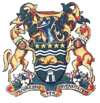Surrey, British Columbia
| Surrey | |||
|---|---|---|---|
| — City — | |||
| City of Surrey | |||
|
|||
| Motto: The future lives here. | |||
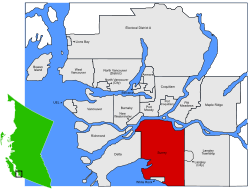 |
|||
| Coordinates: | |||
| Country | Canada | ||
| Province | British Columbia | ||
| Regional District | Metro Vancouver | ||
| Incorporation | 1879 (municipality status) | ||
| 1993 (city status) | |||
| Government | |||
| - Mayor | Dianne Watts | ||
| - City Council |
List of Councillors
Bob Bose (SCC)
Tom Gill (Surrey First) Linda Hepner (Surrey First) Marvin Hunt (Independent) Mary Martin (Surrey First) Barinder Rasode (Surrey First) Barbara Steele (Surrey First) Judy Villeneuve (Surrey First) |
||
| - MLAs |
List of MLAs
Harry Bains (NDP)
Jagrup Brar (NDP) Stephanie Cadieux (LIB) Kevin Falcon (LIB) Sue Hammell (NDP) Dave Hayer (LIB) Gordon Hogg (LIB) Bruce Ralston (NDP) |
||
| - MPs | |||
| - School Trustees |
List of Trustees
SCC)
SCC) SET) SCC) SET) SET) SET) |
||
| Area | |||
| - Total | 317.19 km2 (122.5 sq mi) | ||
| Highest elevation | 134 m (440 ft) | ||
| Lowest elevation | 0 m (0 ft) | ||
| Population (2006)[1] | |||
| - Total | 394,976 | ||
| - Rank | 12th | ||
| - Density | 1,245.2/km2 (3,225.1/sq mi) | ||
| Time zone | PST (UTC-08) | ||
| - Summer (DST) | PDT (UTC-07) | ||
| Postal code span | V3R–V3X, V4A, V4N, V4P | ||
| Area code(s) | 604, 778 | ||
| Website | surrey.ca | ||
Surrey is a Canadian city in the province of British Columbia, Canada, that lies within the Metro Vancouver district of British Columbia. It is the province's second-largest city by population after the city of Vancouver.
The six "town centres" comprising the City of Surrey are: Fleetwood, Whalley/City Centre, Guildford, Newton, Cloverdale, and South Surrey.[2]
Contents |
History
Surrey became incorporated in 1879, and encompasses land formerly occupied by a number of Halqemeylem-speaking aboriginal groups. When Englishman H.J. Brewer looked across the Fraser River from New Westminster and saw a land reminiscent of his native County of Surrey in England, the settlement of Surrey was placed on the map. The area then comprised forests of douglas-fir, fir, red cedar, hemlock, blackberry bushes, and cranberry bogs. A portion of present-day Whalley (named after Harry Whalley, who owned and operated a gas bar at the bend in King George Highway at 108 St., "Whalley's Corner") was used as a burial ground by the Kwantlen (or Qw’ontl’en) Nation.
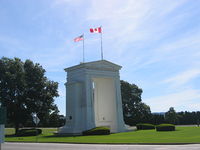
Settlers arrived first in Cloverdale and parts of South Surrey, mostly to farm, fish, harvest oysters, or set up small stores. Once the Pattullo Bridge was erected in 1937, the way was open for Surrey to expand. In the post-war 1950s, North Surrey's neighbourhoods filled with single family homes and Surrey (not yet a city) became a bedroom community, absorbing commuters who worked in Burnaby or Vancouver.
In the 1980s and 1990s, Surrey witnessed unprecedented growth, as people from different parts of Canada and the world, particularly Asia, began to make the municipality their home. Surrey is projected to surpass the city of Vancouver as the most populous city in BC by 2020 - 2030.
Government and politics
.jpg)
Surrey is governed by an eight-member city council. The current mayor of Surrey is Dianne Watts. The last elections were held in November 2008.
In the recent 2009 provincial elections, the British Columbia New Democratic Party won four of Surrey's seats, all of them in the more urbanized north and centre of the city, while the BC Liberal Party won four seats in the more rural east and south.
Following the 2008 federal election, the Conservative Party of Canada holds three of Surrey's four seats (Surrey North, Fleetwood—Port Kells, and South Surrey—White Rock—Cloverdale) in the Canadian House of Commons, with the remaining seat (Newton—North Delta) held by the Liberal Party of Canada.
Geography and climate
The city is characterized by low population density urban sprawl, typical of western North America, which includes areas of residential housing, light industry and commercial centres and is prone to strip development and malls. Approximately 35 percent of the land is designated as part of the Agricultural Land Reserve. The city is mostly hills and flatland, with most of the flatland in Tynehead, Hazelmere, south of Cloverdale, and Colebrook.
The climate is typically inter-coastal Pacific-Northwest: rainy, wet winters, often with heavy rainfall lasting into early spring, with mild, sunny summers and cool autumns.
| Climate data for Surrey | |||||||||||||
|---|---|---|---|---|---|---|---|---|---|---|---|---|---|
| Month | Jan | Feb | Mar | Apr | May | Jun | Jul | Aug | Sep | Oct | Nov | Dec | Year |
| Record high °C (°F) | 15.5 (59.9) |
19.4 (66.9) |
25 (77) |
29 (84) |
34.5 (94.1) |
33.3 (91.9) |
35 (95) |
34.5 (94.1) |
34.5 (94.1) |
29 (84) |
21 (70) |
16.7 (62.1) |
35 (95) |
| Average high °C (°F) | 6 (43) |
8.4 (47.1) |
11.1 (52) |
14.3 (57.7) |
17.6 (63.7) |
20 (68) |
23 (73) |
23.2 (73.8) |
20.5 (68.9) |
14.5 (58.1) |
8.7 (47.7) |
6.1 (43) |
14.5 (58.1) |
| Average low °C (°F) | 0.2 (32.4) |
1.3 (34.3) |
2.8 (37) |
4.9 (40.8) |
7.6 (45.7) |
10.3 (50.5) |
12.1 (53.8) |
12.2 (54) |
9.6 (49.3) |
6 (43) |
2.7 (36.9) |
0.5 (32.9) |
5.9 (42.6) |
| Record low °C (°F) | -17.2 (1) |
-13.5 (7.7) |
-8.3 (17.1) |
-2.8 (27) |
-1.1 (30) |
2.2 (36) |
2.8 (37) |
-1.1 (30) |
-2.2 (28) |
-6.5 (20.3) |
-15 (5) |
-18.9 (-2) |
-18.9 (-2) |
| Precipitation mm (inches) | 185.7 (7.311) |
136.1 (5.358) |
128.7 (5.067) |
100.5 (3.957) |
81.6 (3.213) |
68 (2.68) |
50 (1.97) |
48.7 (1.917) |
64.2 (2.528) |
131.4 (5.173) |
212.3 (8.358) |
202.1 (7.957) |
1,409.2 (55.48) |
| Source: Environment Canada[3] | |||||||||||||
Demographics

As of 2006[update], the population of Surrey is 394,976, a 13.6 percent increase from 2001. The foreign-born population is 150,235, constituting 30.3 percent of the city's population. Visible minorities number 181,005, or 46.1 percent of the population, while Aboriginal people constitute 1.9 percent of the population.[4]
As of 2006, visible minority groups in Surrey are as follows:[4]
- 27.5% South Asian
- 5.1% Chinese
- 4.2% Filipino
- 2.4% Southeast Asian
- 2.0% Korean
- 1.3% Black
- 1.1% Multiple Visible Minority
- 1.0% Latin American
- 0.5% Japanese
- 0.5% Arab
- 0.5% West Asian
- 0.2% Other Visible Minority
The majority languages spoken in Surrey, BC are English, Mandarin, and Punjabi.
Religious profile
- 25.8% No religious affiliation
- 19.2% Sikh
- 16.2% Roman Catholic
- 11.0% Protestant
- 6.4% Other Christian
- 2.9% Muslim
- 2.8% Hindu
- 1.9% Buddhist
- 1.5% Jewish
- 0.1% Coptic Orthodox (Egyptian) Christian [5]
- 0.1% Other Eastern Religion
- 0.2% Religion not mentioned above
Education
Schools
School District 36 Surrey oversees 100 public elementary and 21 public secondary schools, making it the largest public school district in British Columbia. Private schools in Surrey include Holy Cross Regional High School, Pacific Academy, and Southridge School. There are no public middle schools in Surrey, so a typical elementary school includes kindergarten through grade 7, and secondary school starts at grade 8 and continues through grade 12. There are 63,036 students enrolled in public and private schools.
Universities and colleges
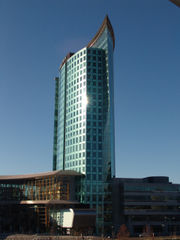
Surrey is home to the third campus of Simon Fraser University (SFU), which opened in 2002. SFU took over the space and programming that was initially built for TechBC, a technical university proposed for south of the Fraser River by the then-NDP led provincial government. SFU Surrey offers a number of cutting-edge programs, including TechOne and Explorations; first-year cohort options; and studies in Applied Sciences, Criminology, World Literature, Business Administration, and Interactive Arts and Technology.
Surrey is also the home of Kwantlen Polytechnic University. Kwantlen opened its doors in the Newton Town Centre of Surrey in 1981. Since then, it has expanded to provide satellite campuses in Richmond, Langley, a trades and technology centre in the Cloverdale Town Centre of Surrey. The Surrey campus focuses on sciences, business, arts, and health, including a publicly accessible wellness centre, while the new Cloverdale campus trains apprentices for the skilled trades industries.
Culture
Attractions
| City of Surrey Museum | |
|---|---|
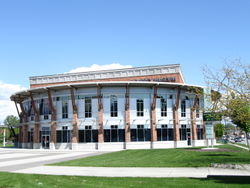 |
|
| Location | Cloverdale, Canada |
| Type | Municipal museum |
| Website | [1] |
.jpg)
The City of Surrey Museum is affiliated with CMA, CHIN, and Virtual Museum of Canada.
Events
Attracting 15,000 people every February since 2004, WinterFest is a day of live music, sporting activities, food, and fireworks, held at the Central City Plaza.
Since 1888, the town centre of Cloverdale has hosted the annual Cloverdale Rodeo and Country Fair at the Cloverdale Fairgrounds every May long weekend. The Fair is Canada's second largest rodeo, and it features 150 acres (0.61 km2) of family-oriented entertainment including agricultural/horticultural exhibits, a western tradeshow, parade, community stages, and the Pacific Northwest Firefighter Combat Challenge.
Due in part to having one of British Columbia's youngest populations, with nearly one-third of all citizens under 18, Surrey has become known for its annual Children's Festival, which began 2004. The free, multi-day festival features circus and clay arts, world rhythm music and movement, popular children's performers, storytelling sessions, and a parade.
Every year on April 13, the Sikh community celebrates Vaisakhi, which often includes a nagar kirtan, or parade, and free food is often handed out. Roughly 100,000 people attended in 2008.[6]
Surrey has the largest Canada Day event of its kind in Western Canada. Presented every July 1 at Cloverdale's Millennium Amphitheatre Park, the event includes amusement rides, a tea ceremony, booths, musicians and performers, and a fireworks show at night.
In 2008, the City, thanks to the federal government's designation of Surrey as Canada's Cultural Capital for the year, put on a three-day multicultural festival. The Fusion Festival celebrated over 60 different cultures through food, music, and dance. The event attracted 60,000 attendees, and will return for 2009. It is expected that the Fusion Festival will become an annual event for Surrey.
Following the success of the Surrey Regional Economic Summit, held in September 2008, in Guildford Town Centre, it is anticipated that this too will become an annual event. The first summit featured BC Premier Gordon Campbell and VANOC CEO John Furlong as speakers and a keynote speech by former New York City Mayor Rudy Giuliani. The event attracted 400 business and community leaders for a day-long conference to discuss issues including public safety, transportation, and sustainability. The second summit is being planned, and will feature former British Prime Minister Tony Blair as keynote speaker.
The Surrey Festival of Dance, an annual event since 1966, is one of the largest dance competitions held in North America, with over 10,000 dancers participating in the multi-week festival.
The Surrey RCMP hold an annual basketball tournament with participation from all the city's secondary schools. The event is the city's largest annual sports tournament.
One of the lesser-known events in Surrey is the annual Nicomekl River Race. Every year, in early June, teams of four meet at Nicomekl Park in Langley, British Columbia to begin the race. Unlike most traditional boat races, the Nicomekl River Race requires that all boats be made by the participants. The racecourse extends from Nicomekl Park to Blackie Spit Park at Crescent Beach. The first team to reach the mouth of the river is awarded a prize of $1000. Additional prizes are awarded to the most creative boat and costume. All proceeds go towards the BC Cancer society.
News media
In addition to news media from Vancouver, the community is served by The Surrey Now newspaper, the Surrey Leader newspaper, and the Peace Arch News newspaper (for South Surrey). The studios of ethnic radio station Red FM are located in Surrey's Newton neighbourhood.
Sports
Every summer, Surrey hosts the Canada Cup International Women's Fastpitch Tournament. It began in 1993 as an international women's fastpitch developmental tournament to help teams prepare for the Olympics by facing top-calibre competition. The event continues to be a fan favourite with gate attendance reaching 93,000 for the nine-day tournament in 2004.
The BCJHL Surrey Eagles hockey team plays at the South Surrey Arena in Surrey. The Eagles won the BCJHL championship, the Fred Page Cup, in 1997, 1998 and 2005; the western championship, the Doyle Cup, in 1997 and 1998; and the national championship, the Royal Bank Cup, in 1998.
Surrey hosted the Canadian national qualifying tournament in 2006, and sends a local team to compete for a spot in the Little League World Series in Williamsport, Pennsylvania.
Surrey is also home to Canada's first kabaddi-specific stadium.[7]
Transportation
History
Surrey was first settled near Crescent Beach, in South Surrey, and Bridgeview/Brownsville, in North Surrey. Soon after, wagons and trails were built, leading to rapid development.
The Semiahmoo Trail, which stretched from White Rock to North Surrey, was one of the first overland trails to bring settlers into the Fraser Valley. The first regular ferry service across the Fraser River started in 1882 on the steam ferry K de K with the point of departure at Brownsville.[8] The ferry landed on the Surrey side at the start of the Old Yale Road, which connected directly inland to Yale, and was a major gold rush trail.
The New Westminster Rail Bridge was opened in 1904, allowing personal vehicles to cross the Fraser River on the upper deck. The lower deck, for rail, enabled BC Electric Railway to finally construct the Interurban line, an electric suburb commuter rail route connecting Chilliwack to Vancouver. It opened for service in 1910, and ran through Kennedy, Newton, Sullivan, and Cloverdale.
In 1937, the then two-lane Pattullo Bridge linking New Westminster and Surrey was opened.
In the early 1950s, BC Electric Railways ceased operating its interurban line, thus increasing the number of vehicles on Surrey roads. Highway 10 was built in 1953, and Highway 15 in 1957. In 1964, the provincial government completed Highway 401 and the Port Mann Bridge; that section of roadway would later be renamed Highway 1. In 1966, the George Massey Tunnel was opened, along with what is known as Highway 99. With the completion of the new Highways 1 and 99, the Fraser Highway and King George Highway became major arterials.
In the early 1990s, Surrey saw the return of rail transit with the SkyTrain Expo Line expansion into Surrey.
Current network
The Canadian National Railway, BNSF Railway, and Southern Railway of British Columbia systems are active and stretch across Surrey to eastern provinces and southward into the United States.
The Fraser Surrey Docks on the Fraser River service more than 400 deep-sea vessels annually, and over 2 million tons of cargo from around the world pass through the terminal. It is the largest facility of its kind on the west coast of North America.
Public transport, operated by TransLink, connects some of Surrey's centres to each other and to other Lower Mainland municipalities. The SkyTrain Expo Line provides 35-minute service to Downtown Vancouver via four stations.
Vancouver International Airport, is 35 kilometres (22 mi) from Surrey by road. Vancouver Airport offers direct daily service to destinations in Canada, North America, Europe, and Asia.
Notable people from Surrey
- Lisa Brokop, singer
- Manmohan Waris, Punjabi singer
- Chuck Cadman, politician
- Ranj Dhaliwal, Best-Selling Author
- Sukh Dhaliwal, politician
- Colin Fraser, professional hockey player; forward for the Edmonton Oilers
- Kamal Heer, Punjabi Singer
- Curtis Fraser, professional hockey player; forward for the Peoria Rivermen
- Daniel Igali, 2000 Olympic gold medalist freestyle wrestler
- Britt Irvin, actress, singer; 2008 Leo Award Nominee
- Jazzy B, singer
- Adam Loewen, baseball player; first baseman/outfielder under minor-league contract for the Toronto Blue Jays
- Gary Nylund, former professional hockey player (Toronto Maple Leafs, Chicago Blackhawks, and New York Islanders)
- Jayson Slack, singer/songwriter
- Kalib Starnes, professional mixed martial artist
- Sangtar, Punjabi songwriter
- John Tenta, professional wrestler, known as Earthquake
- Aaron Voros, professional hockey player; forward for the New York Rangers
- Daniel Wesley, singer/songwriter
- Harbhajan Mann, Punjabi singer
- Nuvraj Bassi, professional football player
- Merk Mikz, Underground Rapper
- Snak the Ripper, Underground rapper
Affiliated cities and municipalities
Surrey has two sister cities:
| Country | City | Province | Date |
|---|---|---|---|
| Kōtō | Tokyo | 1989 | |
| Zhuhai | Guangdong | 1989 |
Surrey also has two Friendship Cities:
| Country | City | Province | Date |
|---|---|---|---|
| Ningbo | Zhejiang | ||
| Taicang | Jiangsu |
References
- ↑ 2006 Community Profiles - Census Subdivision
- ↑ http://www.surrey.ca/Visiting+Surrey/About+Surrey/Surrey+Is.htm
- ↑ Environment Canada—Canadian Climate Normals 1971–2000, accessed 12 July 2009
- ↑ 4.0 4.1 Statistics Canada: 2006 Community Profiles > Search results for "Surrey"
- ↑ 2001 census (percentage out of 340,000 Surrey residents)
- ↑ "100,000 in Vaisakhi parade". Surrey Now. http://www.canada.com/surreynow/multimedia/story.html?id=80aba4d4-7694-4d56-bc1a-55c5afd54464. Retrieved 29 May 2008.
- ↑ Government of British Columbia (9 September 2006). "Premier Officially Opens Surrey Kabaddi Stadium". Press release. http://www.gov.bc.ca/premier/media_gallery/events/2006/sept/premier_officially_opens_surrey_kabaddi_stadium_2006_09_09_35643_o.html. Retrieved 12 January 2008.
- ↑ http://members.shaw.ca/jack_brown/surrey.html
External links
- City of Surrey
- The City of Surrey - A History
- Adopted from Statistics Canada [2][3]
- Tourism Surrey
- Comfort Inn and Suites Surrey
 |
New Westminster | Coquitlam, Port Coquitlam, Pitt Meadows, Barnston Island | Maple Ridge |  |
| Delta | Langley Township, Langley City | |||
| Boundary Bay, Point Roberts (Washington, USA) | White Rock, Blaine, (Washington, USA) |
Sumas (Washington, USA), Lynden (Washington, USA) |
|
|||||||||||||||||
|
||||||||||||||||||||
|
|||||||||||

